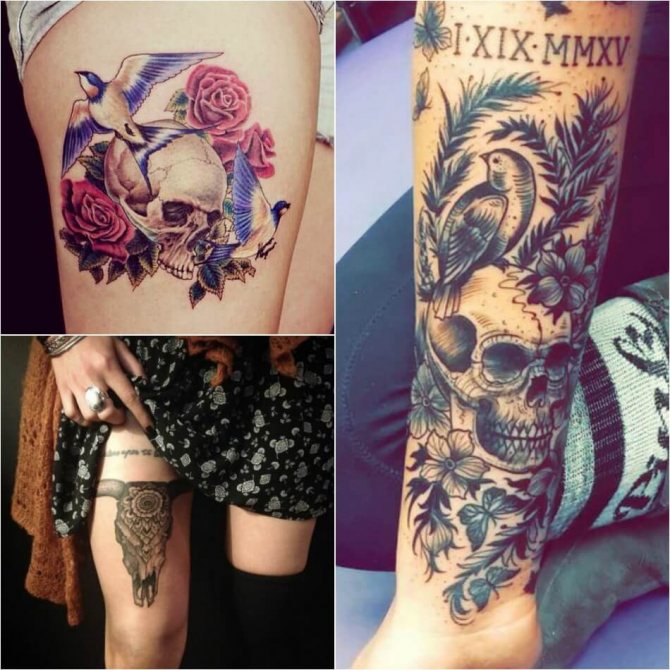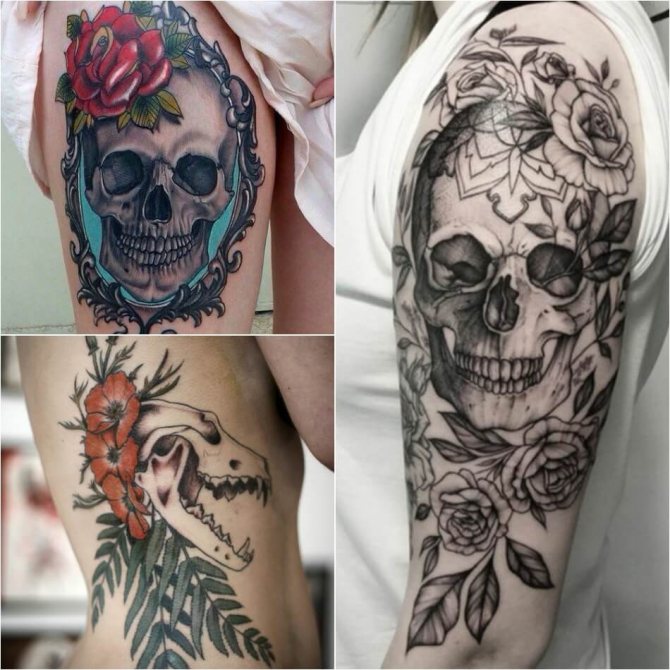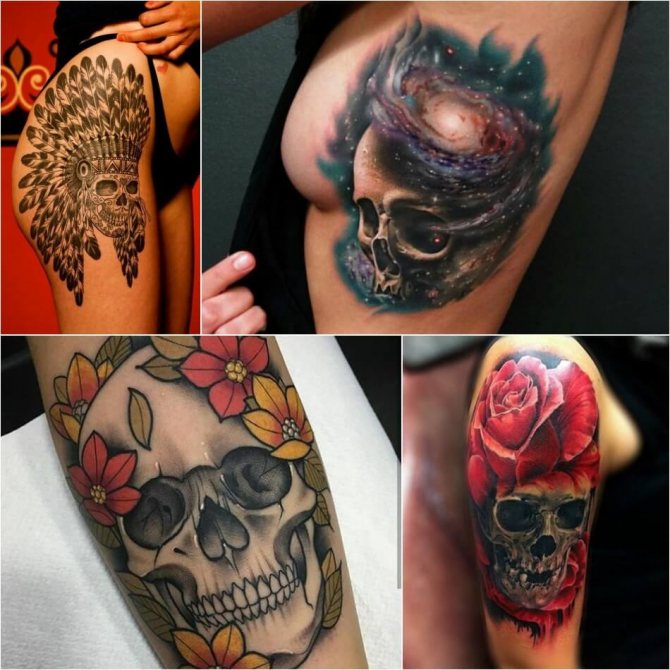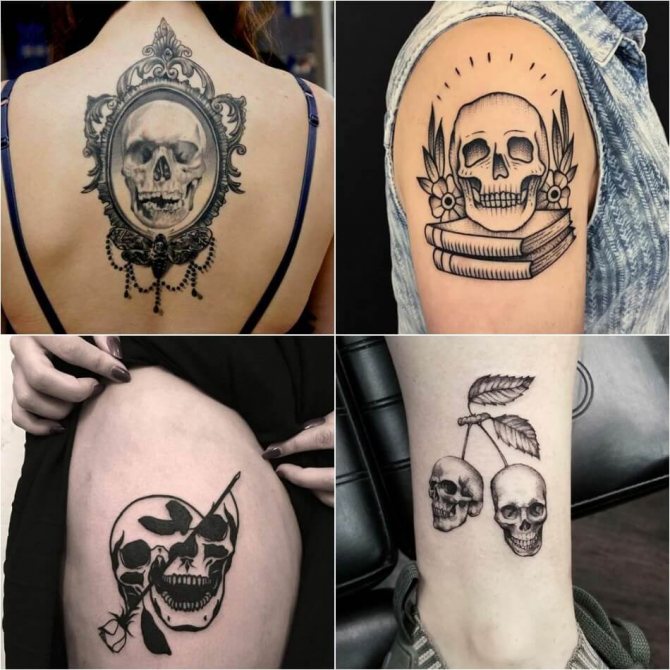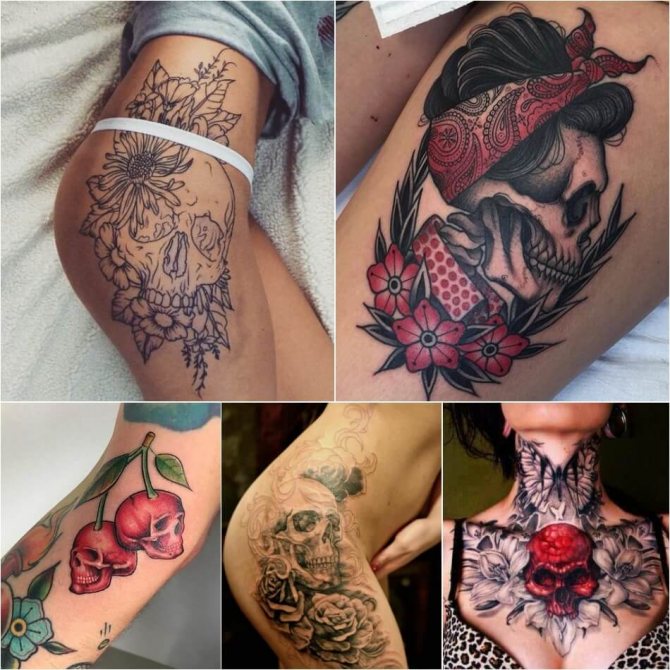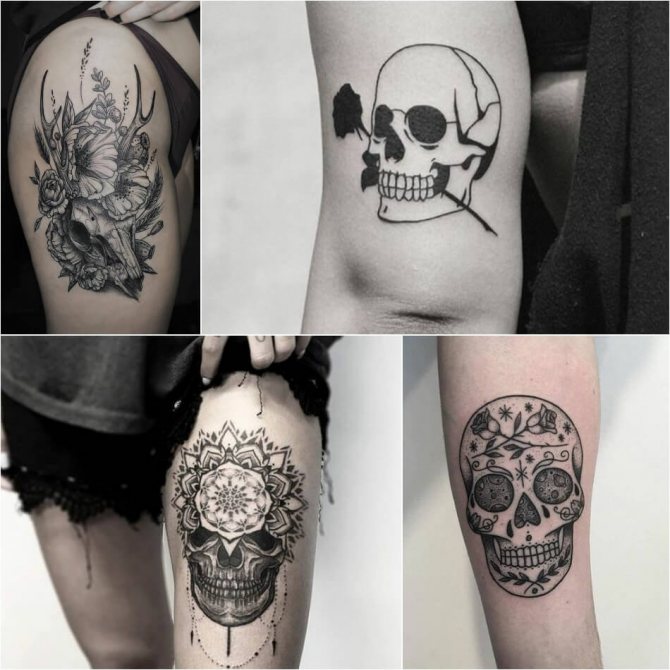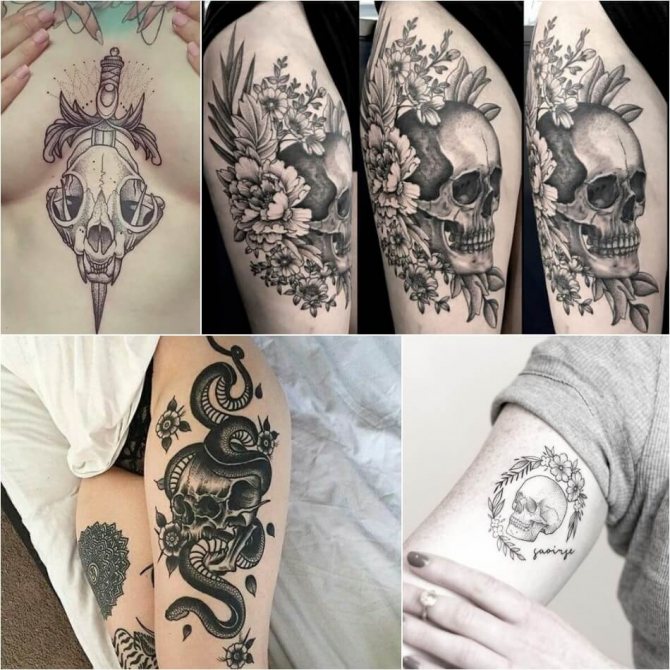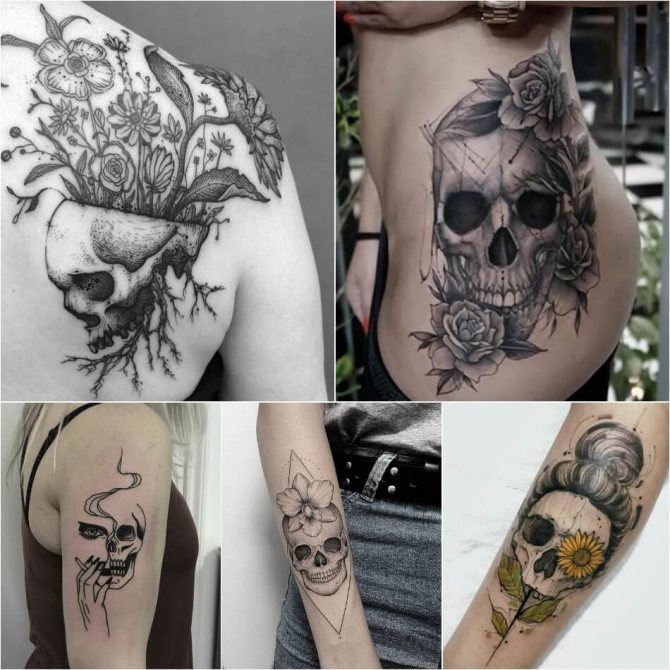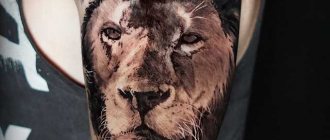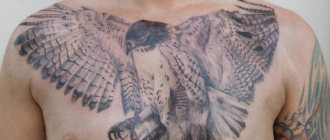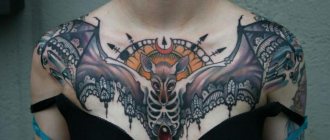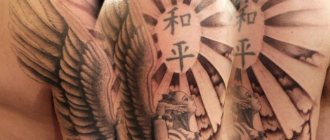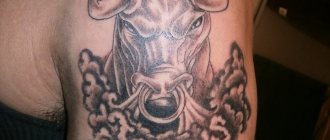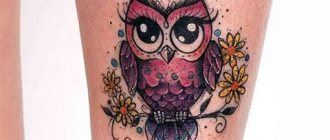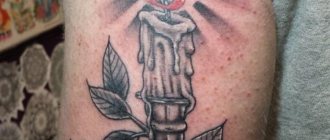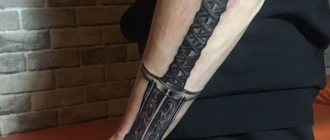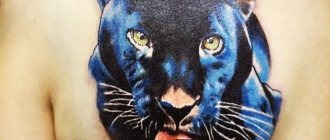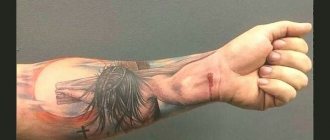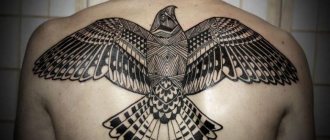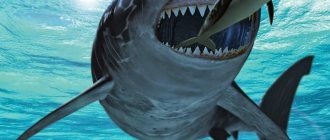Here you can learn all about the meaning and meaning of tattoo beretHere you can see examples of tattoo pictures, learn about their features, options, history and interpretation. More examples here:
- Tattoo pictures beret
- Sketches tattoo beret
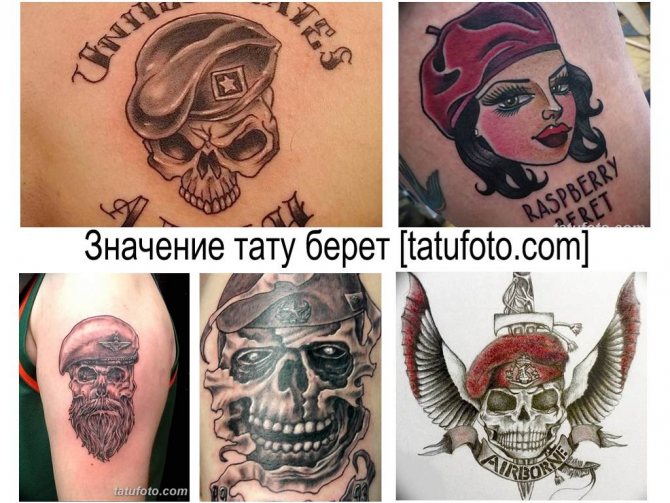
Meaning tattoo beret - a collection of tattoo drawings on photos
The original meaning of the pattern
The skull is one of the most ancient magical and occult symbols. The Slavs, Scandinavians, Scythians, Assyrians, and Persians believed that it contained powerful forces. They used this element in creating amulets and talismans because they believed that it:
- protects against death and misfortune;
- it gives vitality, heals the sick;
- Attracts good luck, helps to win the victory.
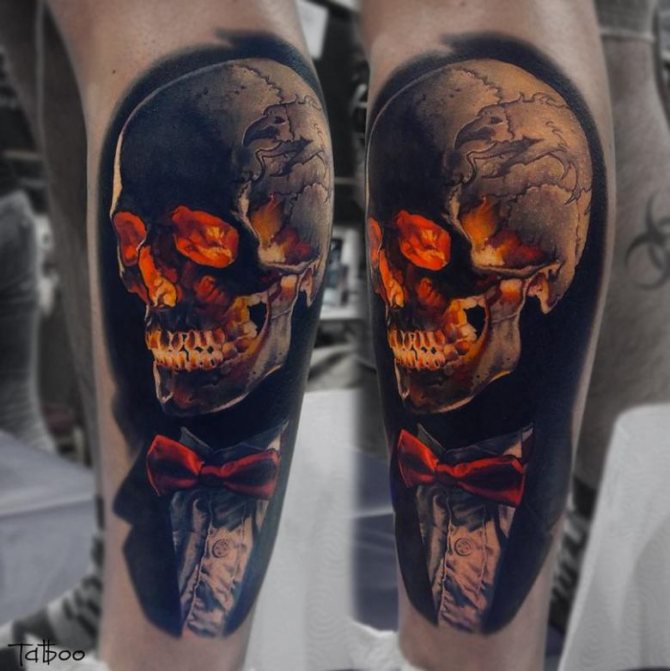

Meaning in girls.
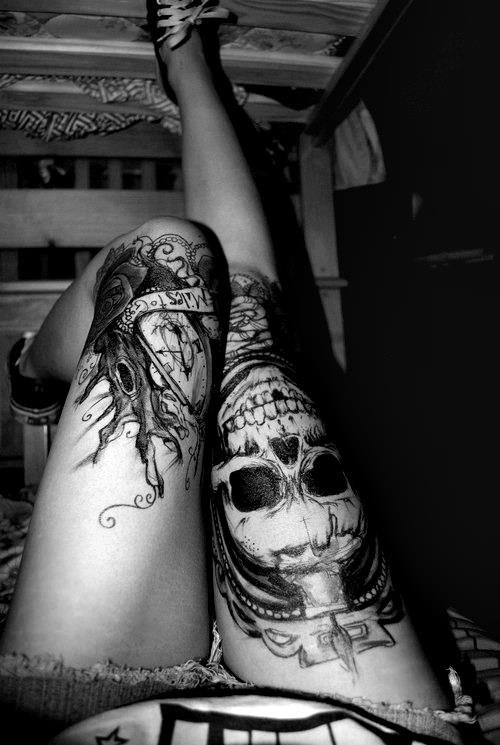

Most often on girls there are lighter and brighter versions of tattoos with skulls: decorated with floral ornaments, some additional elements. Most girls prefer to decorate themselves with such drawings in the zone of the hips, waist or shoulders. Such tattoos symbolize the desire for eternal life and youth, the preservation of beauty and eternal "blooming".
Woman and skull tattoo in prison:
Girls skull tattoo with a snake crawling out of the eye socket has the meaning of wisdom, trials passed and immortality of the soul. Such tattoos girls often get after life's upheavals.
Every year in Mexico there is a special festival called the Festival of Death. In this peculiar carnival, people worship death, celebrating the possibility of life in this world and expressing their reverence for every minute they live. In this celebration, people draw skulls on their bodies in different variations.
Women's skull tattoos
For a woman or a girl, the tattoo is a decoration. They appreciate the beauty, originality, elegance. Even if the basis of the composition is the skull, it is depicted surrounded by leaves and flowers. The other elements should symbolize youth, eternal life, love, rebirth:
- Skull in flowers. An unusual theme that harmoniously combines the symbols of life and death. Means that one must not be discouraged, one must enjoy life and be happy until death comes.
- Lilies are often used as ornaments. They complement the main plot and symbolize innocence, purity, honor. In some cases, lilies can mean fame, honor and respect. Such plots are usually chosen by young girls.
- Skull and rose. Quite a common image. Can mean "love to the grave," but most often shows that this feeling is very closely associated with death. Usually carries a memory of a personal event or experience, the bereavement.
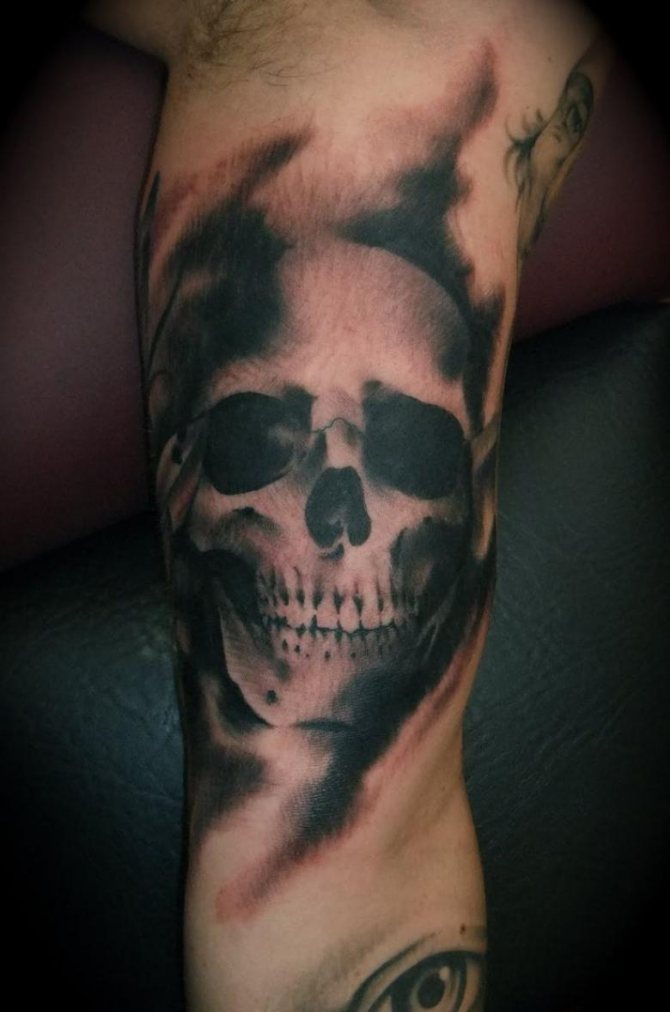

About the skull on the sleeve and the head
Well, who does not know this famous emblem? Probably everyone does. The "dead head" is a kind of symbol. But a symbol of what?
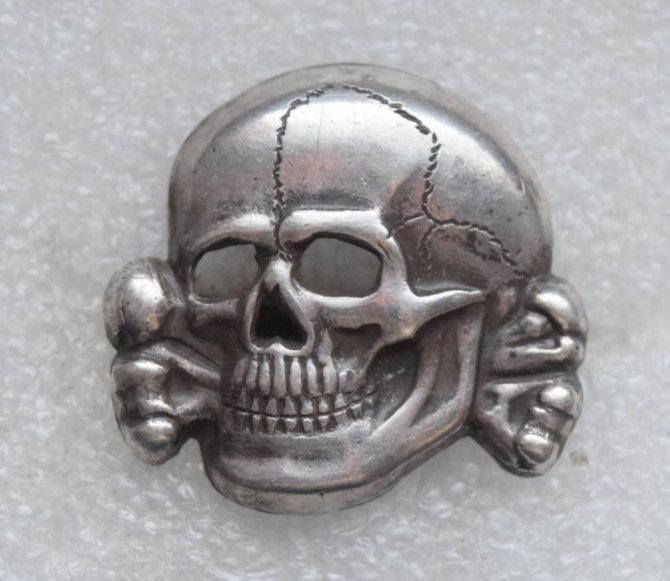

In general, I was surprised to find that the symbol is, in general, quite old. And it was used, let's say, more than originally, but in the Third Reich it was treated... Yes, as usual with the Nazis, when they drew everything by the ears and pulled everything on the globe, which only had more or less suitable diameter.
So let's start talking about the "Dead Head" from a time very far back in time from the Third Reich. Since the Middle Ages.
There was a German poet Garnier von Zusteren. He lived in Bremen in the fifteenth century and was famous for his rather lengthy ballads with a touch of mysticism.
See, there's a knight standing there. His armor is black. His helmet is decorated with a skull. His banner is stained with blood.
Well, all in all Gothic, but it's clear that some as early as the 15th century used skulls as decoration to the fullest extent. And as some evidence of valor, if that is how "a banner stained with blood" is understood.
A little later, in 1740, embroidered with silver thread skull with two crossed bones were decorated with black objects, used during the funeral of the King of Prussia Friedrich-Wilhelm I. Black and silver - quite appropriate for a royal funeral, but Friedrich-Wilhelm has fallen into history, but the skulls remain.
Well, to keep the memory of the King was formed 1st and 2nd Life Hussar regiments, which inherited elements of the funeral dress of the Prussian monarch in their uniforms.
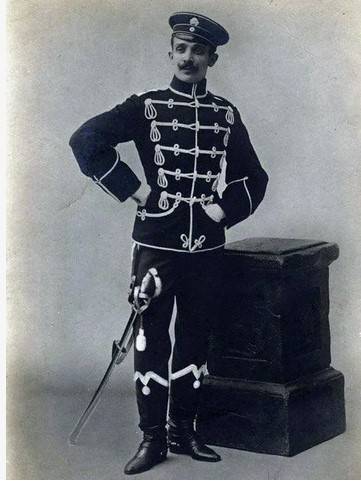

A little later, these hussars formed the 5th Hussar Regiment, which was named without hesitation: "Black Hussars" or "Hussars of Death". People there were selected dashing enough, and in fact came out the unit, distinguished by a particular bravery and cruelty to the enemies.
And on the myrliton (this is a headdress) frightened the enemies of the same "dead head".
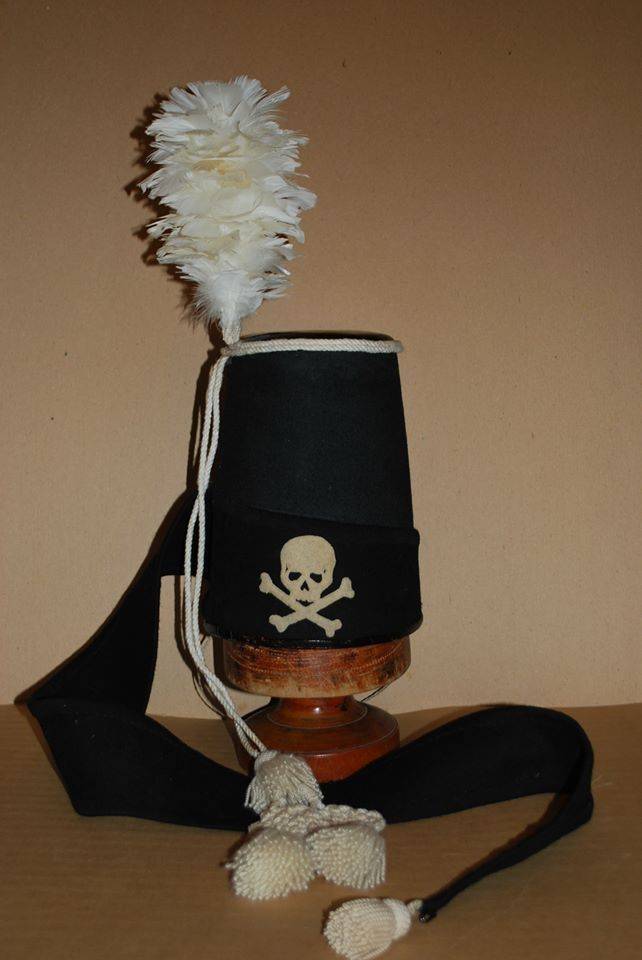

By the way, it was present on the headdresses of quite Russian military. Here is the headdress of hussars of the 5th Alexandria Regiment. From the regiment's museum in Samara. Quite a decent regiment, by the way. The members of the imperial family didn't take weak men for patronage.
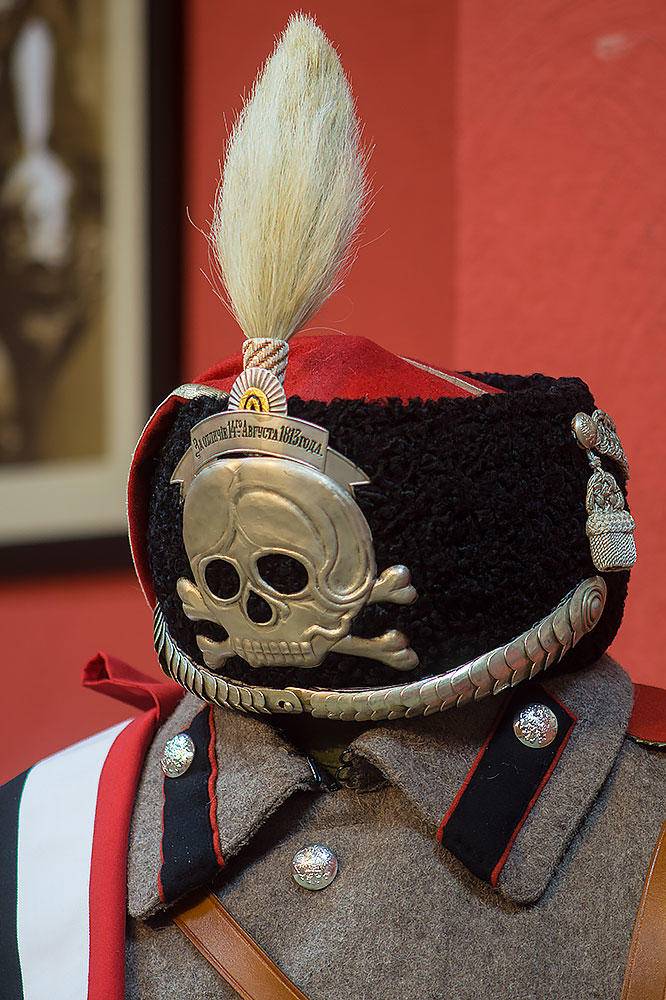

And the breastplate was also peculiar.
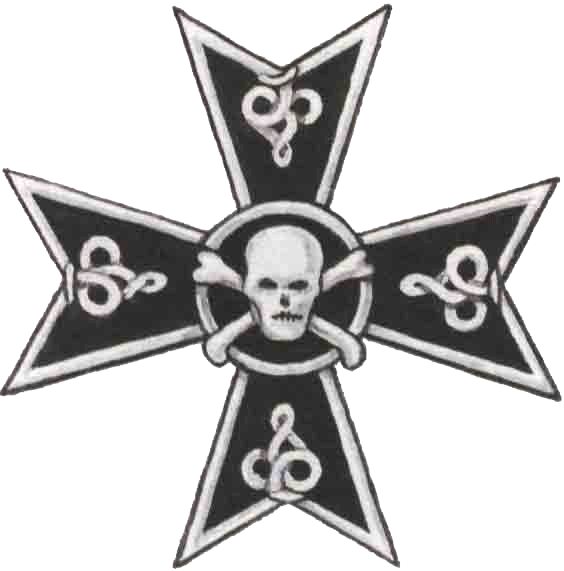

I emphasize boldly: "dead head" was the distinctive sign of Russian hussars of the Alexandria 5th Hussar Her Majesty the Empress Alexandra Feodorovna Regiment. As is the nickname "immortal hussars.
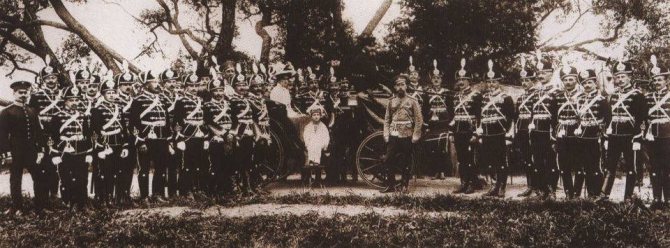

So, you see, and the Russian "dead head" as a symbol of valor was not alien ...
Let us return, however, to Germany. And there existed one more "dead head", Brunswick's one. The Braunschweig "dead head" was somewhat different from the Prussian one - the skull was turned to face straight ahead, and the bones were placed directly under it.
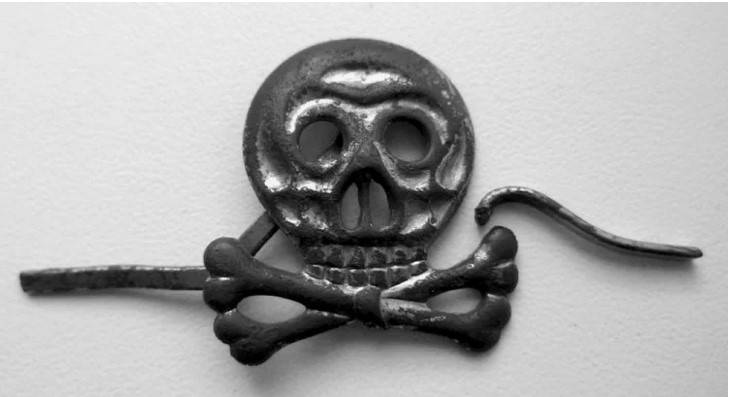

And the parade attila of the Black Hussars:
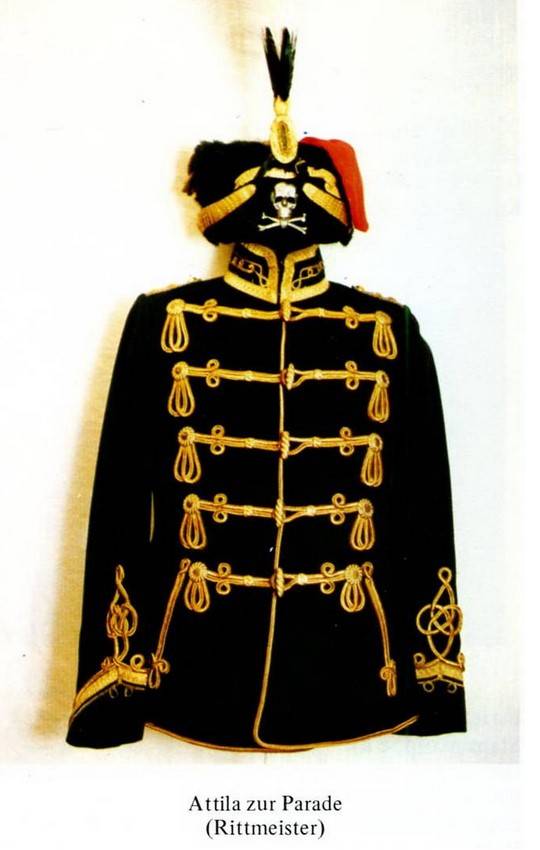

Here, by the way, is another interesting photo: Princess Victoria-Louise of Prussia, chief of that very regiment of Black Hussars. The year is 1909, I think. Quite normal, the princess is the chief of the regiment, wearing the uniform of her unit.
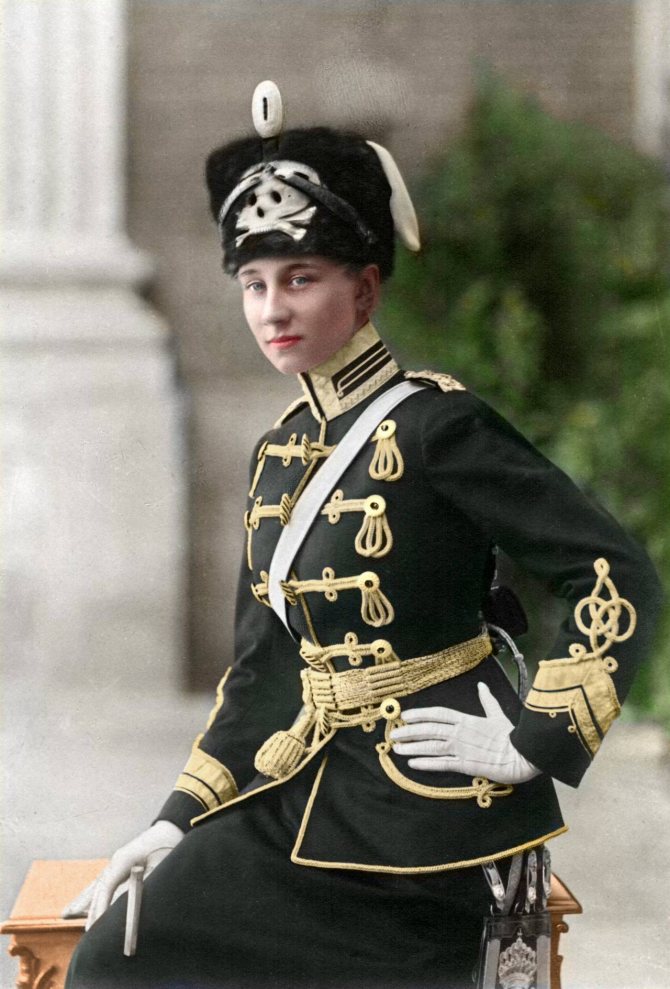

And this was quite normal, because the great Prussian commander, Field Marshal Gebhard Leberecht von Blücher, began his service in the 8th Hussar, and also wore the black uniform of his regiment. One could hardly reproach him for that, as the regiment had a rich history and could be quite proud of it.
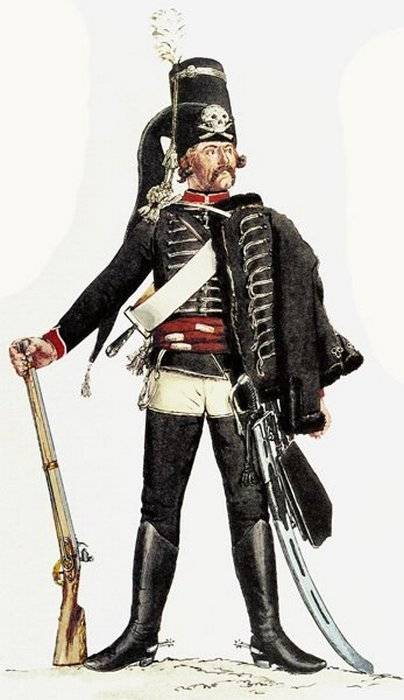

During the First World War the "dead head" became the emblem of shock troops of the German army, first of all assault troops, flamethrowers and tank crews. That is, the newly created kinds of troops, the service in which required great bravery and courage.
And the consumption of personnel there was appropriate. That is why heroic insignia was required. In order not to decrease the flow. And the respect was corresponding.
In 1918, after the end of the war, "dead head" appeared in Russia again. Now it was used by fighters of the Volunteer Corps and Volunteer Death Battalions. On banners, armored cars, and cockades they painted a skull with crossed bones underneath it, which meant readiness to fight to the death.
They fought in different ways, but that's the way it was.
On the whole, the "dead head" became a symbol of bravery, elitism, and readiness for self-sacrifice. It was a badge of honor, like our "Guard".
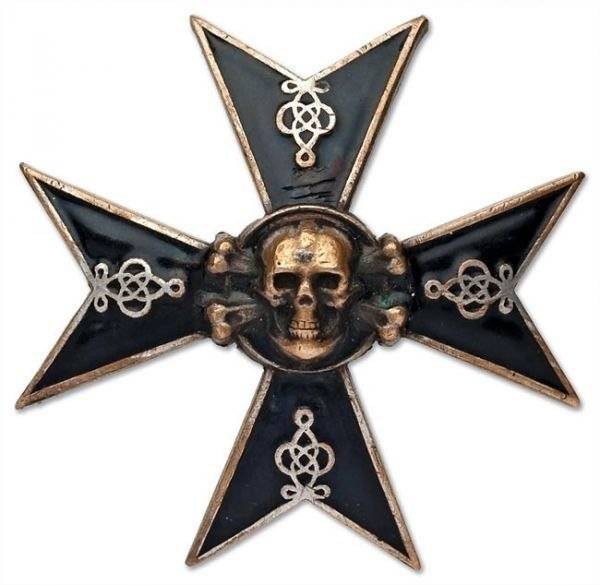

But after the war, there was a lot of bullshit. I mean Germany.
Of course, Germany's defeat in World War I played no small role, giving rise to revanchist movements across the country. Not surprisingly, the citizens of Germany, which had been so well taken over by the victors, wanted very much to live "as it used to be" and were really ready to do a lot for it.
The "dead head" became a symbol of national revanchism. It was worn not only as a cockade, but also on rings, cuffs, tie pins, and other articles of clothing.
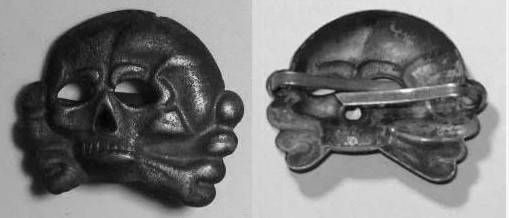

No wonder the Storm Troopers of Rahm and Strasser (and later Hitler) chose the "dead head" as their emblem in 1923.
At first, the Browns wore cockades left over from the war. Then the Nazis ordered from the Munich firm of Deschler a large batch of "dead heads," made in the exact Prussian style, without the lower jaw.
At first the dead head was worn by all storm troopers, then, when the SA units became history in the "night of the long knives", the emblem remained only with the SS.
In fact, there was something about it. Of course, the SS liked some sort of continuity. "The Black Hussars were the guards of the Prussian kings, and the SS... Well, they were essentially the guards, too.
Well, that's pretty much how it went. Continuity, revanchism, tradition...
In 1934 there was a little coup d'état in the uniforms. The Prussian "dead head" as an emblem was given to the first tank units, created on the basis of the cavalry units. And the SS sent a new type of "dead head" with a lower jaw.
The "dead head" of 1934 was produced in three variants: turned to the left, to the right, and straight. It was worn as a cockade by all members of the SS.
And in general it was affixed everywhere. On buttonholes, daggers, necklaces, jackets, service and parade tunics, drums, bugles and some decorations.
Yes, speaking of awards it is worth mentioning and the ring "Dead Head" or Totenkopfring - a personal badge of honor issued personally by Heinrich Himmler to members of the SS.
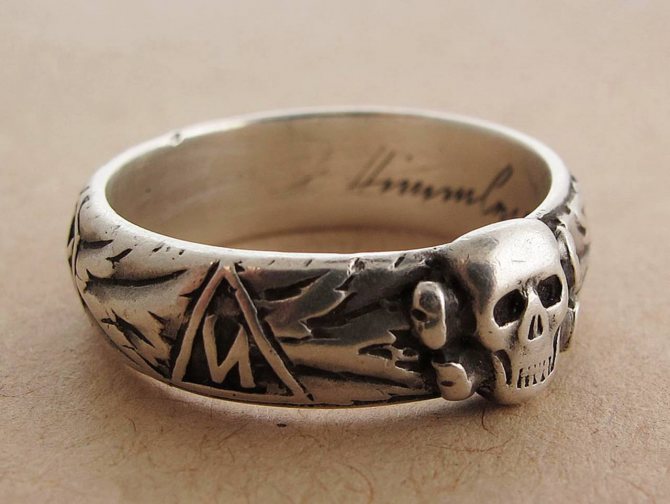

Initially the ring was awarded to senior officers of the "old guard" (there were less than 5,000 of them) who demonstrated outstanding courage and leadership qualities in combat. But later the rules for obtaining the ring were simplified, and by 1939 almost every SS officer who had served for more than 3 years could have this award.
The award was lifetime. If the owner died or left the SS, a silver ring with a skull was to be surrendered to Himmler to be returned to Castle Wevelsburg as a memento of the owner. If the owner of the ring was killed in battle, his comrades-in-arms were to make every effort to return the ring and prevent it from falling into enemy hands. By January 1945, 64% of the 14,500 rings had been returned to Himmler, a testament to the very clear work of both the Soviets and the Allies.
In the spring of 1945, all the rings stored in Wevelsburg were buried under an artificially induced avalanche on the orders of Himmler. They have not been found to this day.
In addition to the SS, the "dead head" was usurped by some services of Danzig, where the Black Hussars were quartered. The "dead head" was chosen as an emblem by the Danzig militia (Heimwehr Danzig) as well as the Danzig police and fire department.
In addition, the "dead head" has served as the emblem of some units of the German armed forces since World War I. These are the 5th Cavalry Regiment, 17th Infantry Regiment, Coastal Defense Detachment Danzig, and the Air Force combat groups Schleppgruppe 4 and Kampfgruppe 54.
We understand that the "dead head" was a real symbol of elitism, and the right to wear it was already a high award in itself. Well, and it was supposed to remind the wearer that he had to be willing to die in the name. Simply in the name.
Now let's move clearly to the Third Reich and the SS.
If you look carefully and thoughtfully, probably no name of the Third Reich's own is associated with as many tall tales as the "Dead Head. I am intentionally capitalizing it now, because it was different from the previous name. After all, we are going to talk about a unit, or rather several.
The first, and, in fact, the most sinister. These are the "Dead Head" units, aka SS-Totenkopfverbände, SS-TV. An SS unit responsible for guarding the concentration camps of the Third Reich.
The name SS-Totenkopfverbände itself is difficult to translate successfully into Russian. I will allow myself to interpret the word verbände as "alliance, association." With Totenkopf everything is clear. In other words, the output is "Dead Head Union. And indeed, the youngsters were actively dragging the "dead head" everywhere they could get their hands on it.
Naturally, since these gentlemen were in charge of guarding the concentration camps, they all had their hands in blood. It's kind of an uncontested case. It is clear that images of these units are not worth dirtying up the article, I hope that is clear.
It was possible to distinguish members of the "Dead Head" units from ordinary SS men by their buttonholes. Instead of the traditional two runes for the SS troops, which we are accustomed to call "lightning bolts", they bore the emblem of the "Dead Head": a skull and crossed bones. With a lower jaw. These units were created... that's right, in 1933, just when Himmler's SS took the place of the SA Rehm and Strasser storm troopers.
And yes, the "deadheads" wore to the last the very black uniforms that the rest of the SS had actually abandoned. The reasons were simple - those who had fought at the front could actually live a little longer, because we had quite a "soft spot" for the black SS uniform. Therefore (it was already written about more than once) the closer to the front, the less black uniforms there were. But in the rear it was quite possible to cantle.
And so these "dead-head" bearers were quite at ease in the camps and, by the way, were mostly spared a minor scare at the end. Although some of them got what they deserved.
But the second bearers of the "dead head" were more famous.
We are talking about the 3rd SS Panzer Division "Dead Head". The division was formed, as it becomes clear, from excessive zeal. Nevertheless, in November 1939 in the SS training camp in Dachau this unit as a motorized infantry division appeared.
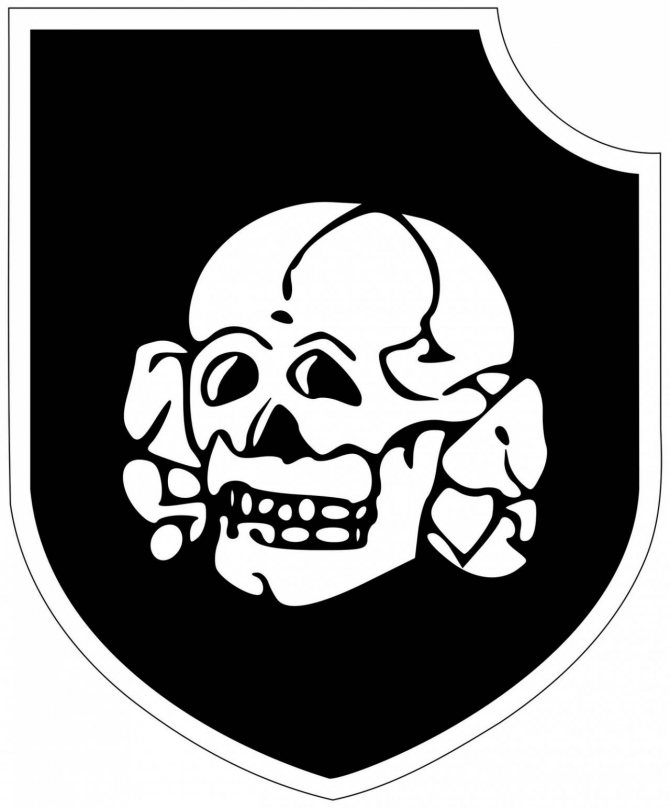

The core consisted of guards from the SS camp units, officers from the SS reinforcement units, and the Danzig Heimwerk (militia) of the SS. The first commander was the founder of the "Dead Head," concentration camp inspector Theodor Eicke.
In general, they recruited executioners (read about the Danzig militia if you're interested) and went to war.
Here it is worth mentioning the rumors. Rumors were greatly helped by memoirs and recollections, including from our side. If you collect all the books and films from Soviet times which mention "Dead Head," it turns out that it fought in all parts of the Eastern Front, and many times was destroyed completely.
Perhaps there is not a more or less large partisan unit that has not confronted and defeated the Dead Head.
In reality, of course, it was not like that. But neither did the kind of "victories" to which the "Deadheads" in the concentration camps were accustomed.
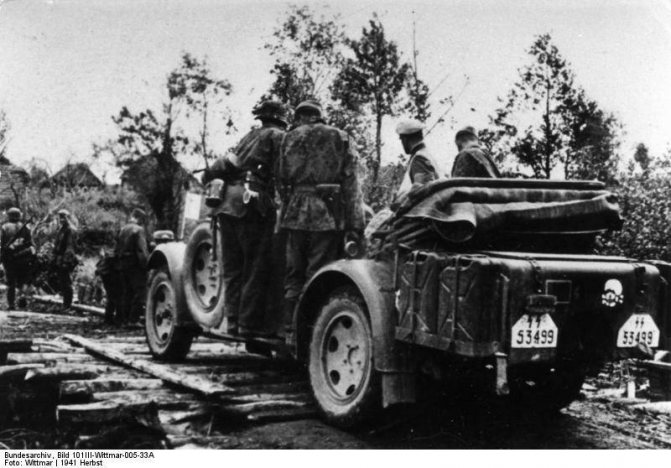

The division began its fight on July 2, 1941 near Daugavpils, but already on July 9 it had to be replaced by the 290th infantry division and was taken out for reinforcement. The 21st mechanized corps of the future general of the army and twice Hero of the Soviet Union D.D. Lelushenko and the 42nd tank division did their work. The "Dead Head" was given a simply deafening blow, the division fought virtually in a week.
It is strange for July 1941, when the Red Army was allegedly beaten up and down, isn't it?
And in the future, "Dead Head" was picking at Leningrad without much success. But the most interesting thing was ahead. But in front of it was Demiansk and the second spanking, as a result of which between January and October the "Dead Head" left 80% of the personnel in our land, and in the end the remnants were withdrawn to re-form and "honorable" rest in France.
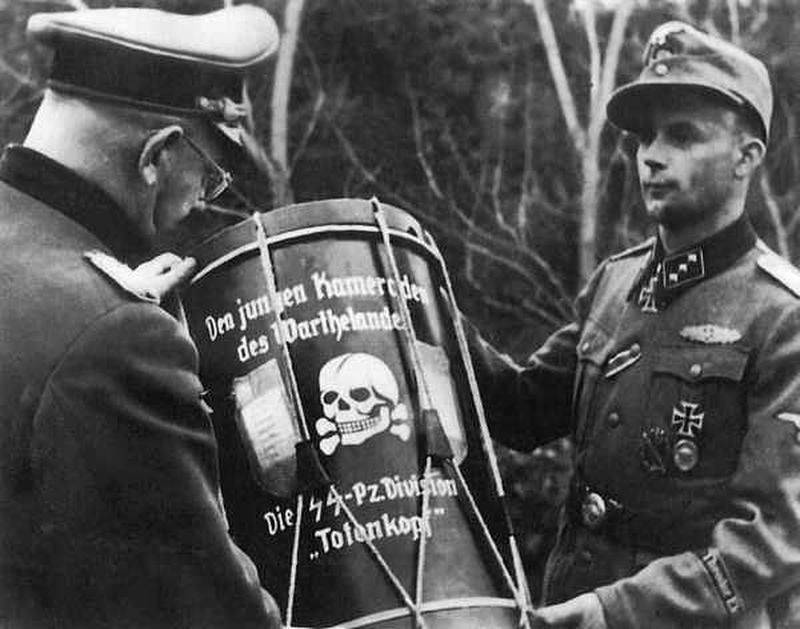

Then there was a third return to the Eastern Front, in which the division conducted itself quite decently in principle. However it had no effect on the general picture and instead of heroically dying for the Third Reich, in the spring of 1945 the remnants of the division had marched from Hungary to Austria, where they capitulated to the Allies.
It should be said that the "Dead Head" had no special feats. They fought, yes, they fought quite well, but not in a way that was on the lips. The only thing clearly attributed to the story is the counter-guerrilla action. In reality, here the 3rd Division has a tough alibi: the Division actually never left the front, and if it did, it was in such a state that it obviously had no time to fight with the partisans.
However, there is one nuance. Until the very end of the war there was a rotation of personnel between the division and the detachments in the camps. After being wounded the soldiers of the division were sent to rest. To concentration camps, where they carried guards.
In general, to put it simply, every "dead-head" had to be shot. In the head. As well as any SS man. Just in case.
But, as a matter of fact, the "dead-head", i.e. skull and bones, is actually quite an old thing. And it's not so nasty, as it becomes clear when you look at it point-blank. Just a badge of honor, nothing more.
But that's the way it is with us, you can ruin anything if you want to. So it is not surprising that a rather ancient badge of valor was relegated by the Nazis.
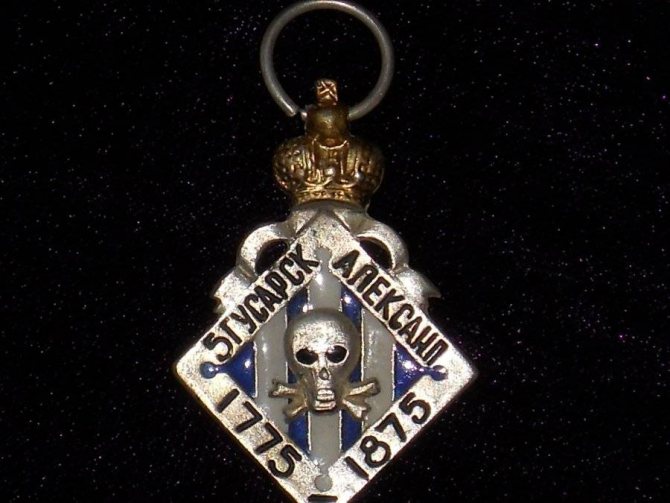

I recommend reading: Konstantin Zalessky. "SS. The Security Detachments of the NSDAP". Alexander Simakov. "The Defeat of the "Dead Head" Division. Demian disaster of the SS".
Men's tattoos with a skull
For men, it is not the aesthetics that are important, but the symbolic meaning of the tattoo. They choose the image of the skull to emphasize their brutal qualities, courage and tenacity. Usually it is part of a more complex composition and is combined with one or more secondary elements:
- Skull in a crown. This plot is considered a classic. It is chosen by self-confident, ambitious men to denote their goals. But the crown is not only a symbol of power. It is associated with great knowledge, wisdom and life experience.
- The watch reminds us that life is short, and after it will inevitably come death. But there is another interpretation, which advises to enjoy every moment and not to get upset because of minor problems.
- If there is a snake in the composition, the drawing emphasizes the person's intelligence, vast experience, wisdom and understanding of life.
- The cross does not mean anything in particular, but evokes appropriate associations. The otherworldly theme is used by Goths and members of other subcultures interested in mysticism and the occult.
- If the picture shows a girl, the man lost the woman he loved or was a victim of betrayal or infidelity. Sometimes this tattoo is considered a talisman.
- The presence of wings symbolizes freedom and independence. Sometimes this plot is chosen by rather self-confident and selfish people. Above all, they value their own views, and other people's opinions will always remain secondary to them.
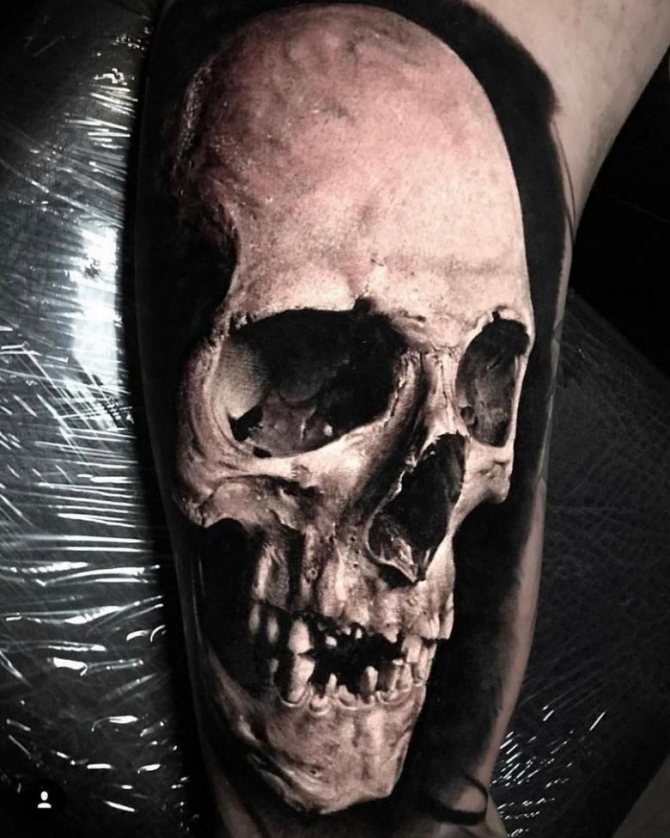

Men often get tattoos depicting animal skulls braided with leaves and flowers. They usually symbolize certain character traits:
- If a man chose the ram's skull, it means he wants to emphasize willpower, tenacity, stubbornness, the ability to stand up for his opinion and achieve his goals.
- The deer skull is borrowed from Slavic, Celtic and Scandinavian mythology. It means that good triumphs over evil, and spiritual values are more important than material goods.
- The goat skull evokes the wrong associations. If you look at the photos of finished works, there are often elements resembling occult signs. But the tattoo has nothing to do with magic. It symbolizes strength, wisdom, energy and good health.
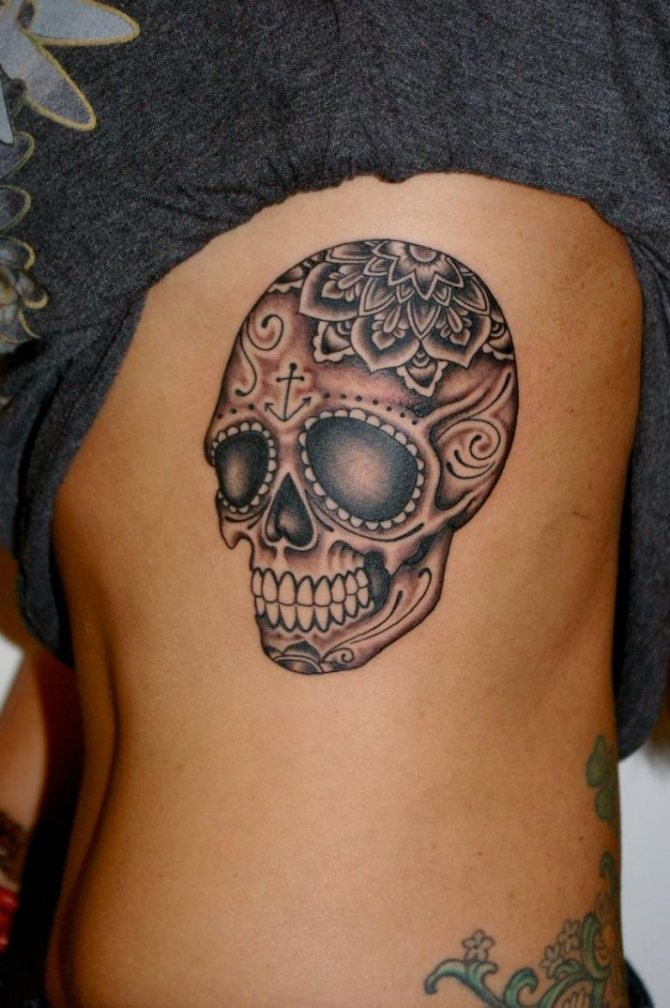

The specifics of the tattoo.
Berets are used as part of tattoos by people who served in the paratroopers or marines. The Airborne or Marines choose several basic combinations:
- a skull in a beret;
- A shield with a beret hanging from it;
- a lion with a beret;
- a tiger with a beret;
- sword with wings and beret.
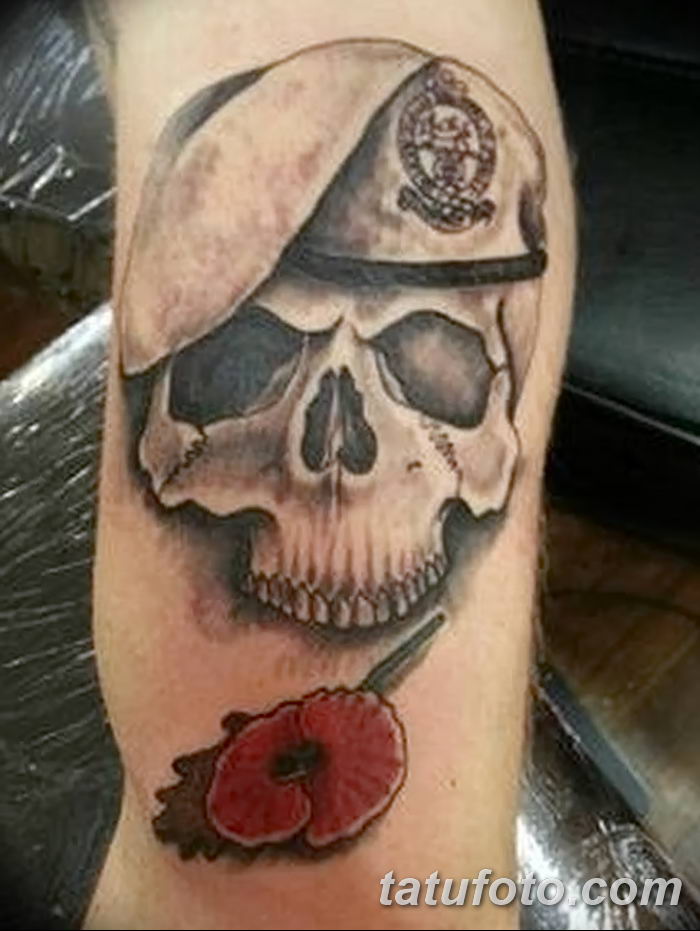

Paratroopers tend to have tattoos on their left shoulder. Along with the years of service. Very often such images are complemented by the motto of the airborne troops "No one but us".
People who have been in combat situations tattoo their blood type or other important information along with their tattoos.
Different military units wear different types of berets. Even if the tattoo is no longer distinctive except for the headgear, the military will be able to figure out what troops the wearer served in:
- Blue berets are worn by those serving in the airborne forces.
- Black berets are worn by infantry soldiers. For some time, black berets were also worn by tank crews.
- People who served or are serving in the border troops wear green berets.
- The legendary "speckled beret" - a dark crimson cloth - is issued to the soldier of military special forces, who passed a special training course and successfully passed the exams.
Who is suitable for a tattoo with a skull?
Tattoos with the image of the skull is one of the most popular motifs. They emphasize a person's individuality, his willingness to differ from others, to abandon templates and stereotypes, to live by his own rules. Very often such a drawing is chosen:
- bikers and truckers (as amulets);
- Representatives of informal movements and various subcultures;
- Non-ordinary people who want to stand out, to draw attention to themselves.
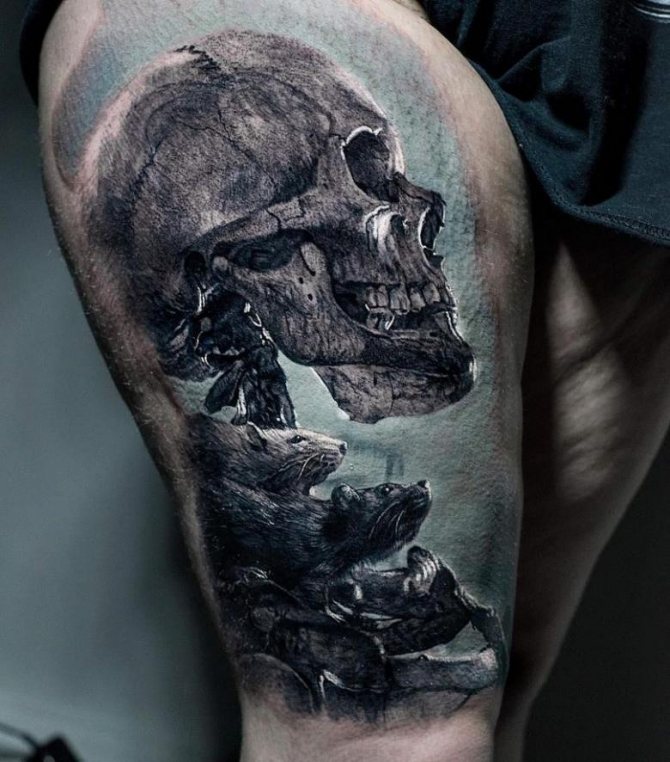

Tattoo skull - Female Skull Tattoo
Skull choose bold and risky girls. Not every girl is ready to do a large tattoo with a grim aesthetic. But today, the framework between male and female subjects is losing its relevance. If just a decade ago, the skull tattoo could be found except among female bikers or rock stars, today this image is close to many. Instead of brutal gloomy sketches modern girls also give preference to a refined minimalist subjects.
Prison tattoos with a skull
In prison tattoos, all elements carry deep meaning and tell a story about a person's life, outlook and situation. It is important that tattoos with a skull do not mean belonging to the prison caste, they can be done by anyone. But it is better to choose a neutral drawing, which is not used in the criminal world:
- Brightly pronounced teeth and painted black eye sockets mean that a person is ready to defend his opinion, is not afraid of obstacles, does not succumb to pressure. Such a drawing is considered a symbol of courage, carefree attitude to life, rejection of the system and official laws.
- Cracks or a hole in the forehead show aggressiveness and ruthlessness of the person, his readiness to achieve the goal by any means, to eliminate all obstacles.
- Stabbed dagger symbolizes the desire for revenge. Nakolka is common in the criminal world. A defiant and aggressive theme, emphasizing cruelty and intolerance toward law enforcement officers and those prisoners who cooperate with them.
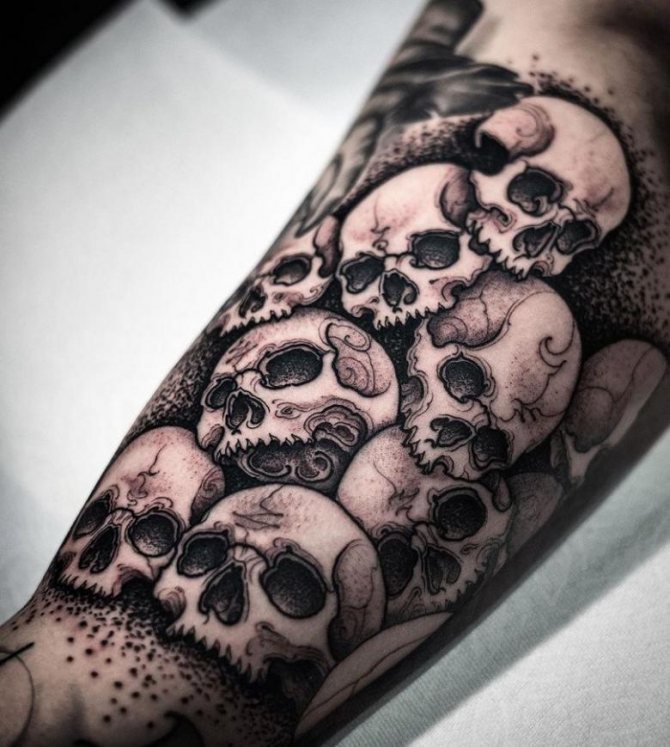

Basic meanings.
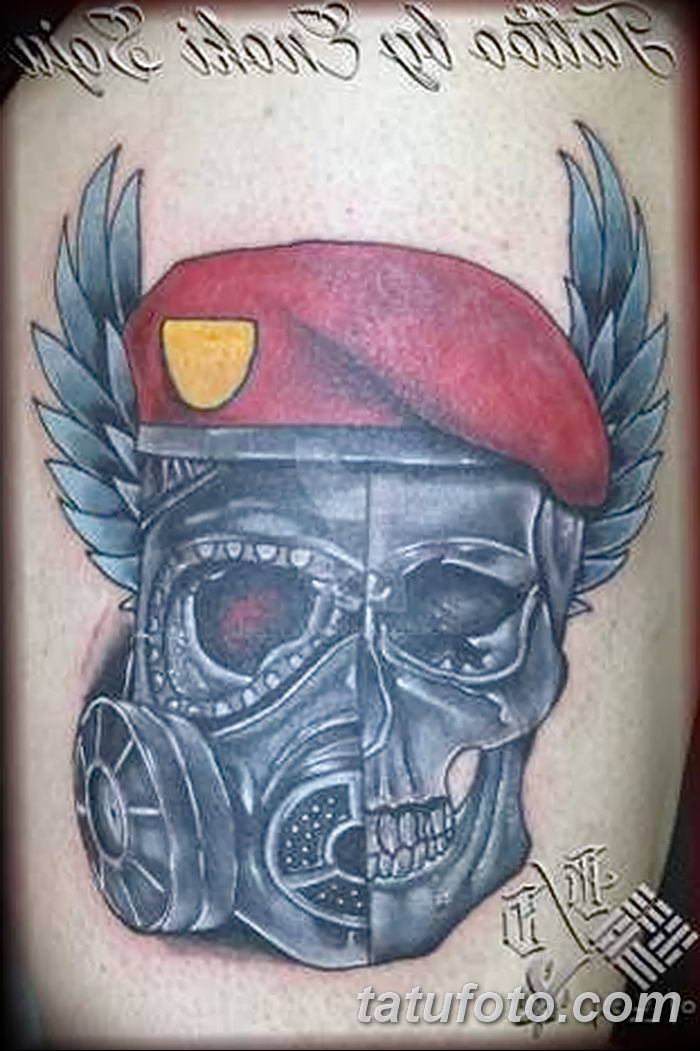

Men who apply various variations of beret tattoos to their bodies want to emphasize their masculinity. The beret is a symbol of belonging to a particular type of military forces. For men it is not just a decoration and they refer to such images very seriously.
It is believed that any military tattoo is not made for nothing. Their application still needs to be earned. Spend a certain amount of time in the service, take part in various combat missions, get a rank, etc. After all, another soldier may ask what merit you have done such a tattoo.
Photo examples of tattoos with berets:
1 ... Next "
(click to see more photos)
But berets are worn not only military. It's also a civilian headgear. The word "beret" most often conjures up associations with artists or France. Cute black-haired girls in berets, stripes and red light scarves. White and blue color scheme with bright accents of red. This is probably the most common and recognizable image of the Frenchwoman.
Such a tattoo can signify a love for France and everything French. Or the desire for sophistication and grace. Beret in combination with a palette of colors and brushes will show belonging of the owner of the tattoo to the artists.
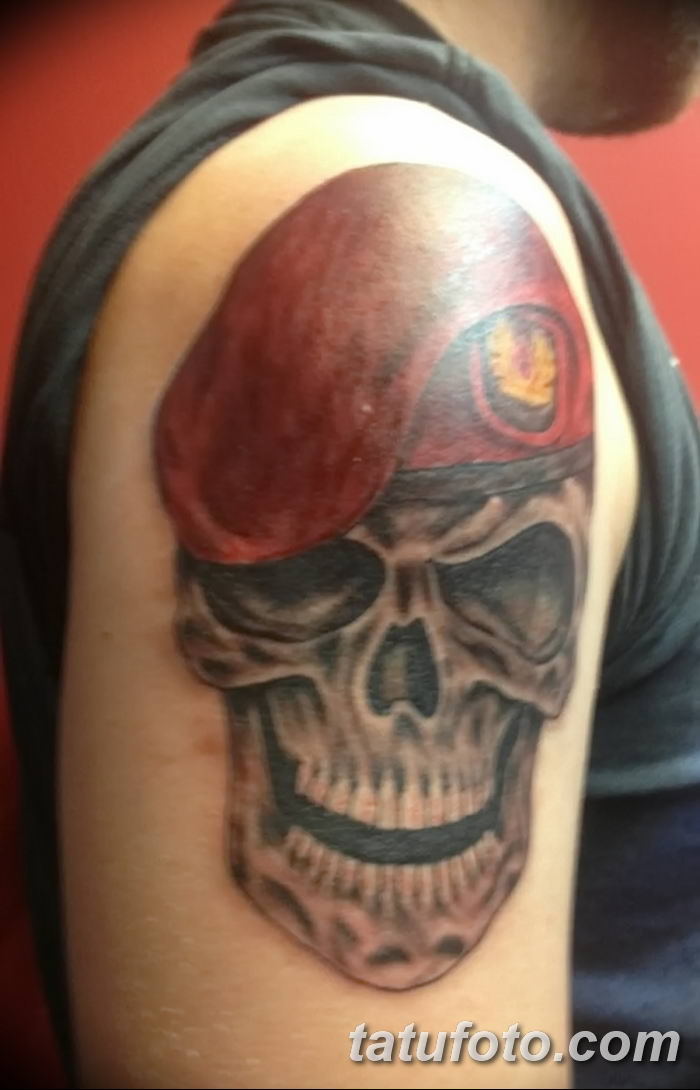

Where can a skull be tattooed?
A tattoo that includes this spooky symbol can be done on any part of the body. Men usually prick the picture on the back or chest, shoulders, hands. Women most often place such a tattoo on the back of the hands, sometimes on the feet.


Options for execution
The tattoo can not be done exactly according to the template. A good master will definitely add individual features to it. Any idea can be implemented in different ways. Modern body art includes many techniques and directions. Here are the styles that are appropriate for skull tattoos:
- Classic execution is characterized by bold lines, shading and a limited color palette. Many people prefer this style, seeing in it a certain charm.
- Dotwork tattoos consist of a huge number of dots of different sizes. As a result, you get a clear, bright and peculiar drawings.
- A style that imitates a sketch or outline. This consists of separate strokes of different brightness and thickness, made with hard and soft pencils. Looks spectacular and original, requires the highest skill.
- Maximum realistic drawing with elaboration of the smallest details and transfer of halftones. Usually includes all shades of black and gray. The lack of sharp outlines and smooth transitions make it indistinguishable from the photo.
- Trash Polka is a relatively new trend. The drawing is done in red and black and resembles a spontaneous piling up of elements. On such a background would look good with a clearly drawn skull, partially immersed in chaos.


The skull is an interesting and peculiar element. It can be pinned separately or inserted into a complex composition. The result is a symbolic image with deep meaning, allowing a man to reveal his character, to tell about his lived life, destiny and dreams.
Meaning in guys
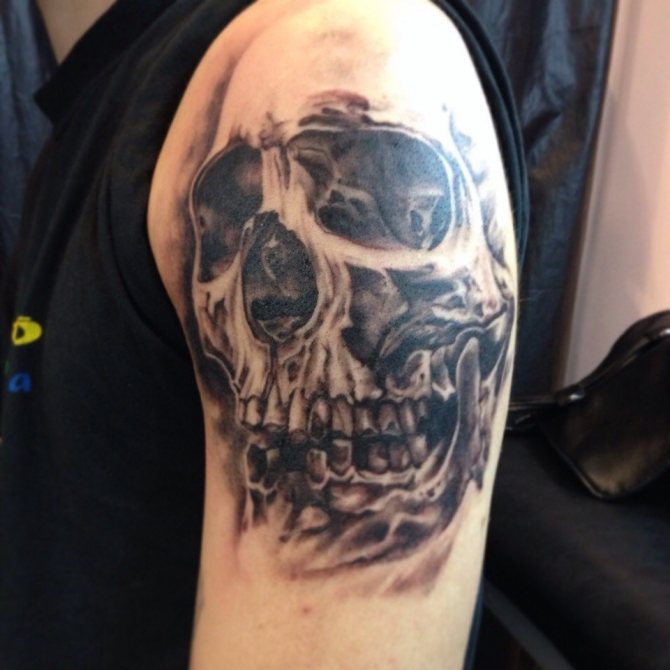

The meaning of the skull tattoo is universal, and usually such a tattoo has a common meaning for both girls and men. But differences in the drawings on the body with skulls rather variations and the zone of the body on which they are located. Men more often prefer to stuff skulls in the fire, or just black skulls without additional elements.
Often in the male sex you can find a tattoo in the form of a skull with crossed bones. This is an ancient pirate symbol. Previously, only people connected in one way or another with the gangster world, robbery and debauchery had such tattoos on their bodies. Over time, this symbol came to signify death and everything associated with it.
The meaning of such tattoos is virtually the same - the perishability and mortality of all that exists in the world. People who tattooed such a tattoo often looked death in the eye or faced it with the will of fate. Perhaps the impressions or thoughts of death and decay left a deep imprint on them that led to a desire to adorn their bodies with such a tattoo.
Sometimes the tattoo of the skull has the meaning of sacrifice. Often such a drawing on the body in the area of the back and shoulders stuffed guys of certain subcultures or movements. In their ranks, the skull tattoo more often means openness and even worship of death and everything associated with it.
The meaning of military tattoos: meaning, history and photos
The meaning of military tattoos is a topic of interest to the vast majority of tattoo lovers. In this material we will tell you about the meaning and significance of different military tattoos, offer for those who are looking for an interesting drawing, the following sections of the catalog of photos of tattoos:
- Photos of finished military tattoos
- Sketches for military tattoos
What is the meaning of military tattoos?
The category of military tattoos refers to people who are serving or have served in the military. The military's desire to put images on the body can be explained by the desire to protect themselves or the need to identify them after death. For example, a blood type tattoo can save a soldier's life during an injury. It is assumed that it is the tattoos with the symbols of the blood group became the ancestors of other images on the body with practical meanings. For example, next to the blood group may be an inscription prompting medics about diseases, diabetes, allergies and others. For example, a tattoo of a blood group may indicate a medical condition, diabetes, allergies, etc. The inscription is applied to the shoulder, wrist, but most often on the chest.
The military has its own traditions in applying tattoos. The meaning of military tattoos depends on the military specialty. For example, special forces officers depict a skull or predator, snipers put a terrorist in the optical sight, scouts - a bat or an owl. The meaning of the military tattoo may also depend on the type of troops. Having certain symbols of distinction on the image, you can determine what kind of troop the soldier is related to.
Airborne troops - depicts a parachute, a winged sword with a beret on a shield, the emblem of the airborne troops. Often the airborne troop tattoo has a grinning tiger, bear, wolf, leopard or leopard. The predator may be depicted in a blue beret. A skull is also depicted in the beret. A very beautiful picture is a flying airplane, with a parachutist flying in the background with a parachute unfolding. The famous simple airborne troop tattoo is the ribbon "For Airborne Troops". We continue to parse the meaning of military tattoos in different variations of drawings.
What do the military tattoos of the Navy and Reconnaissance mean?
Navy - depicts an anchor on the background of a globe, a ship, a submarine, sailboats, a steering wheel, a dolphin jumping out of the waves, a wind rose, an inscription on the rib of the palm "For the Navy!" Like airborne troop tattoos, Marines may have a skull, a predator in a black beret, or a simple ribbon tattoo that reads "Marine Corps."
Frontier troops apply symbols of border protection, namely the shield and sword. With the shield, the abbreviation PoV and a star can be drawn. A border guard tattoo may have a green beret, border guard posts, a guard tower, or a landscape in the form of mountains. Also a border guard tattoo can be in the form of an eagle or a scorpion.
Intelligence and special forces - the symbol is a bat, on a dark background, which symbolizes the night. Bat tattoo can be depicted with the moon, applied skulls in berets or some landscape.
The most uncomplicated military tattoos are a picture on the forearm of the wristband of one's unit. In some cases, soldiers are forbidden to get tattoos, such as scouts so that they will not be identified or "spirits" in the army until they have completed a certain period of service. Military tattoos have great meaning and life meaning. Any military tattoo is not done for nothing - it has to be earned.
You can take a look at:
Meaning in the "zone."
A certain and different from the general meaning have similar tattoos in the zone - in their circles. Most often such a tattoo in a person who is in the MLS, the zone or out of them means belonging to the thieves' circles and the presence of any power.
Usually the skull tattoo is stuffed with people of some degree of authority who have served time in the colonies. What does a particular thieves tattoo means you can only find out from its bearer.
The meanings of tattoos are an interesting and mysterious topic. You can discover the history of various drawings and more and more details about their designations to better understand the world of tattoo art and body art. If you have any questions about this material, you can ask them in the comments to this post. I recommend you to add this site to your bookmarks, because you may need it more than once.
